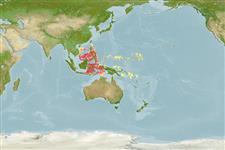>
Anguilliformes (Eels and morays) >
Congridae (Conger and garden eels) > Congrinae
Etymology: Macrocephenchelys: Greek, makros = great + Greek,kephale = head + Greek, enchelys, -yos = eel (Ref. 45335).
More on author: Fowler.
Environment: milieu / climate zone / depth range / distribution range
বাস্তুসংস্থান
সামুদ্রিক ব্যথিডিমারসাল সমুদ্র তলদেশবিহারী; গভীরতার পরিসীমা 635 - 1012 m (Ref. 129313). Deep-water
Indo-West Pacific: few widely scattered locations, east coast of Madagascar; Indonesia (Makassar Strait), Malaysia (northeastern Borneo), Taiwan and Vanuatu.
আকৃতি / ওজন / Age
Maturity: Lm ? range ? - ? cm
Max length : 80.0 cm TL পুরুষ/ লিঙ্গ অনিধর্ারিত ; (Ref. 129313)
Short description
সনাক্তকারী নির্দেশক | বহিঃ অঙ্গ সংস্থান | মরফোমেট্রিক্স
কশেরুকা : 173 - 183. This species is distinguished from its congeners the following characters: body is more elongate with depth at anus 2.2-5.9 %TL, more delicate and flexible; head is shorter 7.1-9.5 %TL, 25.6-36.2 %PAL, 1.8-2.8 times in trunk; dorsal-fin origin is well behind the tip of pectoral fin; vertebrae more numerous 173-183; supratemporal pore present; fleshy papillae on lower jaw, but not dorsally on head; no sensory pits on the ventral surface of head and anterior body (Ref. 129313).
Life cycle and mating behavior
পরিপক্কতা | প্রজনন | ডিম ছাড়া | ডিমসমূহ | ডিম্বধারন ক্ষমতা | শুককীট
Lin, J., Shao. K.-T. and D.G. Smith, 2018. The eel genus Macrocephenchelys (Anguilliformes: Congridae) in Taiwan, with description of a new species. Zootaxa 4454(1):186-199. (Ref. 129313)
IUCN Red List Status (Ref. 130435: Version 2024-1)
Threat to humans
Harmless
Human uses
মৎস্য: আকর্ষণবিহীণ
হাতিয়ার
Special reports
Download XML
ইন্টারনেট সুত্র
Estimates based on models
Preferred temperature (Ref.
123201): 8.9 - 16.3, mean 12.3 °C (based on 32 cells).
Phylogenetic diversity index (Ref.
82804): PD
50 = 0.7500 [Uniqueness, from 0.5 = low to 2.0 = high].
Bayesian length-weight: a=0.00063 (0.00029 - 0.00138), b=3.18 (3.00 - 3.36), in cm total length, based on LWR estimates for this (Sub)family-body shape (Ref.
93245).
ট্রফিক পর্যায়ে (Ref.
69278): 4.0 ±0.5 se; based on size and trophs of closest relatives
স্থিতিস্থাপক (Ref.
120179): মাধ্যম , সর্বনিম্ন প্রজন দ্বিগুনের সময় ১.৪-৪.৪ বৎসর (Preliminary K or Fecundity.).
Fishing Vulnerability (Ref.
59153): Moderate to high vulnerability (52 of 100).
